If you’ve ever stepped into an old Damascene home or seen a Syrian TV series with stunning interiors, you’ve already had a taste of this magical art. It’s called many names—Damascus Art, Damascene Ornamentation, Ajami Art, Raised Ornamentation—but whatever you call it, this traditional craft is one of the most beautiful and intricate parts of Syrian heritage. It turns plain wood into vibrant, luxurious masterpieces using handmade designs, bold colors, and real gold or silver touches. This is not just decoration—it’s the identity of Damascus carved into walls, ceilings, and even furniture. Let’s take a closer look at where it came from, what makes it so unique, how it’s made, and why it’s fighting to stay alive today.
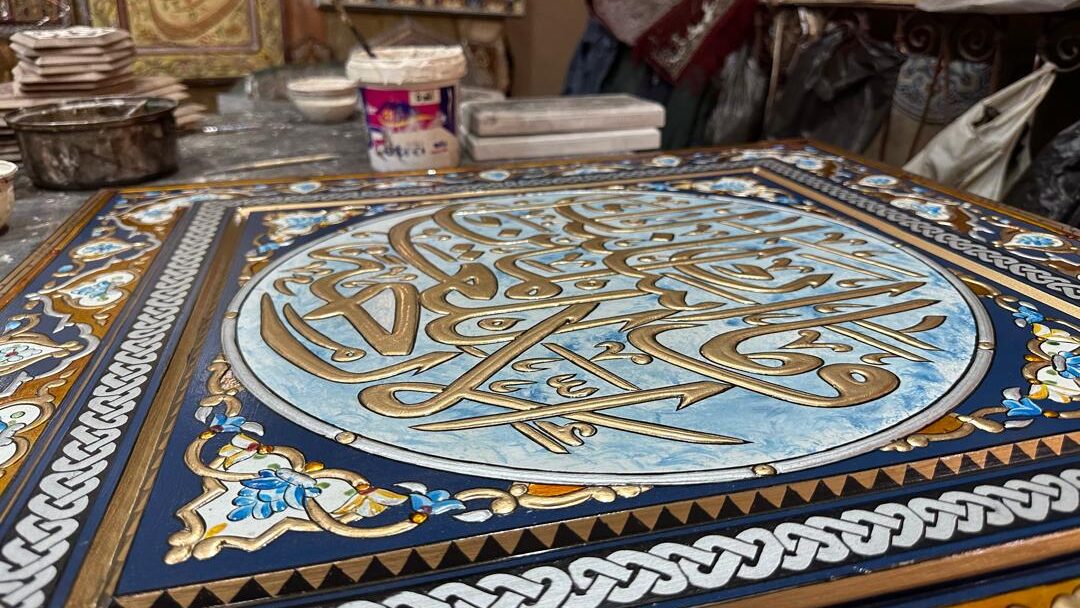
What Is Damascus Raised Painting?
Imagine walking into a room where the walls and ceilings aren’t just painted flat but have patterns and shapes that actually pop out—raised like tiny mountains and valleys. That’s Damascus Raised Painting in a nutshell. It’s a traditional craft where artists create decorative designs that literally stand out from the surface. The designs often show delicate leaves, flowers, and geometric patterns inspired by nature and classical Islamic art.
This craft is all handmade, which means every detail is touched by a human hand with care and skill. The colors aren’t random splashes—they’re carefully chosen to fit the vibe of the space and often carry deeper meanings. What’s truly amazing is that when these artworks are looked after, their colors and shapes can stay vibrant and beautiful for hundreds of years! So, if you’re into art that tells a story and holds history, this one’s for you.
A Peek into History: How Old Is This Art?
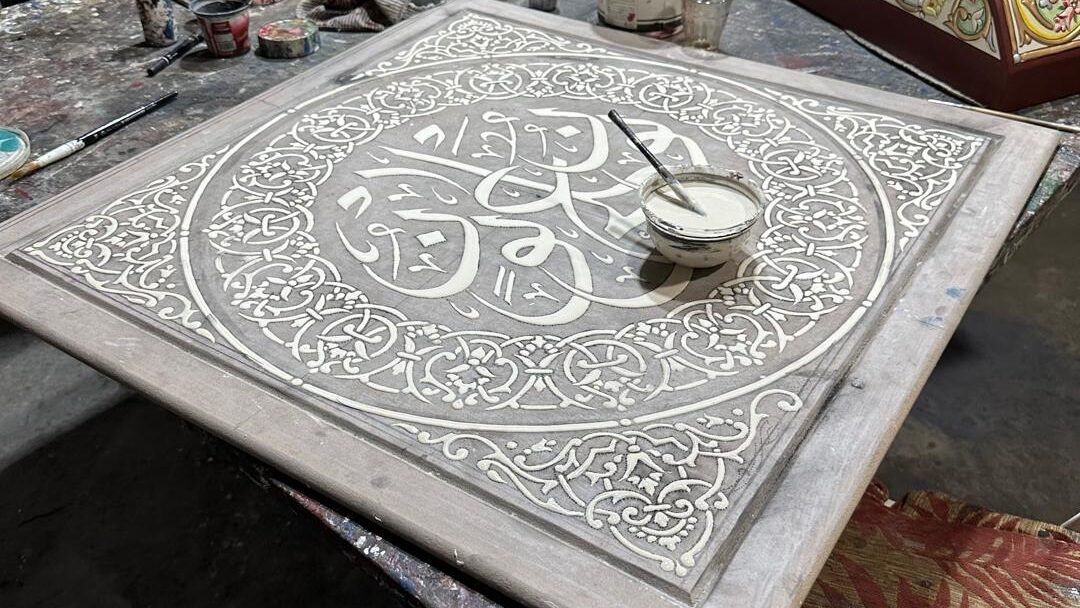
This art form is a real piece of Damascus’s soul. Some experts say it’s been alive for more than 500 years, with one craftsman tracing the oldest known example back to 1540. Others believe the tradition might be even older—up to 1400 years! The roots of this craft stretch all the way back to Jerusalem, where the first designs were created inside the Al-Aqsa Mosque. Then it made its way to Damascus’s Umayyad Mosque and eventually decorated the homes of the city’s elite during the Umayyad era.
Walk through any old house in Damascus, and you’ll likely spot some of these magical raised decorations. In fact, one of the oldest known rooms with this art dates back to 1455 AD, nestled in the old Umayyad architectural area. What’s even cooler? Back in the day, all the paints and materials were natural—colors came from plants, flowers, and stones. It’s art that’s connected deeply to nature, just like the designs themselves.
What’s in a Name? The Story Behind “Ajami” and “Damascus Painting”
Here’s a fun twist: this art goes by several names, but not everyone agrees on the “right” one. You might hear it called “Ajami Art,” “Raised Decoration,” or even “Islamic Art.” But many craftsmen, especially a respected figure named Muhammad Haj Qab, insist the correct name is “Damascus Painting” or “Shami Painting”—because this art truly belongs to Damascus and reflects its spirit.
Muhammad Haj Qab explains that the name “Ajami” isn’t really accurate. It’s a more recent label that might have come from Ottoman times or from outsiders who noticed similar decorations in places like Iran and Uzbekistan. But those aren’t the same, and “Ajami” means something like “non-Arab” or “mixed origin,” which doesn’t capture this art’s unique Damascus identity. Interestingly, the name “Damascus Painting” was officially recognized at a conference back in 1993, putting a spotlight on its true roots.
Thanks to popular TV shows featuring Damascene homes, this art form gained more attention worldwide, especially under the “Damascus Art” name. So, when you talk about this craft, you’re really talking about something that belongs to the heart of Syria’s capital city.
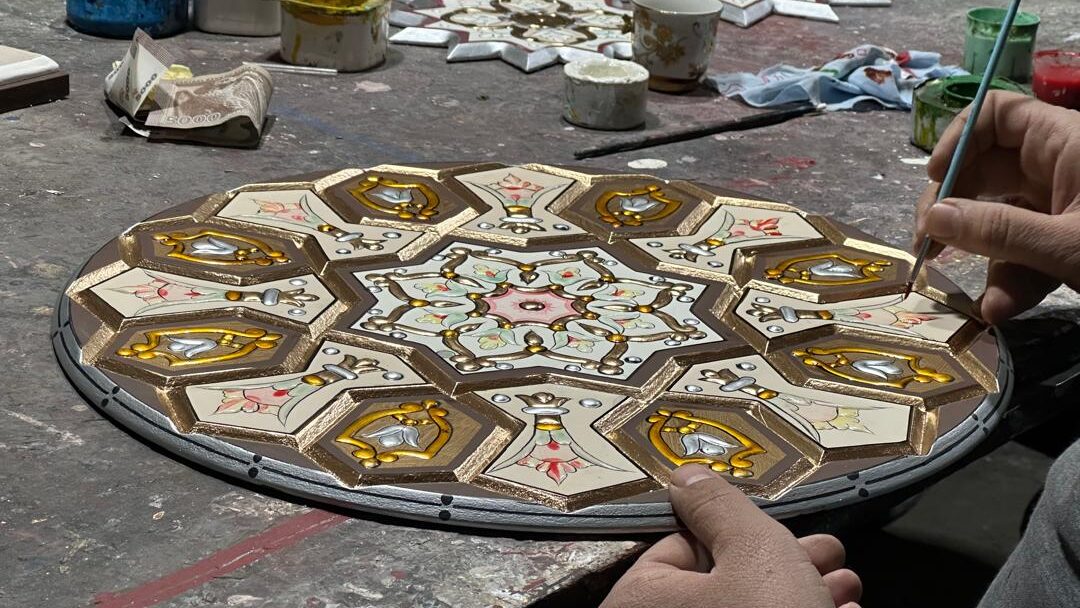
The Making of a Masterpiece: Step-by-Step
Creating Damascus Raised Painting is no quick or easy job—it’s a labor of love that can take months to finish just one piece! Here’s how it’s done:
- Designing: First, the artist draws the design carefully on paper. This sketch is the blueprint for the whole piece.
- Perforating: The drawing is then pierced with tiny holes along the lines so charcoal dust can pass through.
- Transferring: The perforated paper is laid on wood, and charcoal dust is rubbed over it, leaving a dotted outline on the surface.
- “Raising”: This is where the magic of raised decoration begins. Using a fine brush and a special material, the artist builds up the raised lines and shapes, giving the art its 3D texture.
- Coloring: Colors are applied with care, often mixed by hand using natural pigments. The palette is balanced to bring harmony to the design.
- Gilding: A shiny gold or silver finish is added to highlight details and add a touch of luxury.
- Defining Lines: The raised lines are outlined again to make the shapes stand out clearly.
- “3D”: The trickiest step! Precise geometry and calculations are used to make the raised parts really pop in a three-dimensional way.
- Finishing Touches: The artwork is varnished for protection, and the back is insulated to keep it safe once installed.
Each stage requires incredible patience, precision, and skill, and every tiny detail counts.
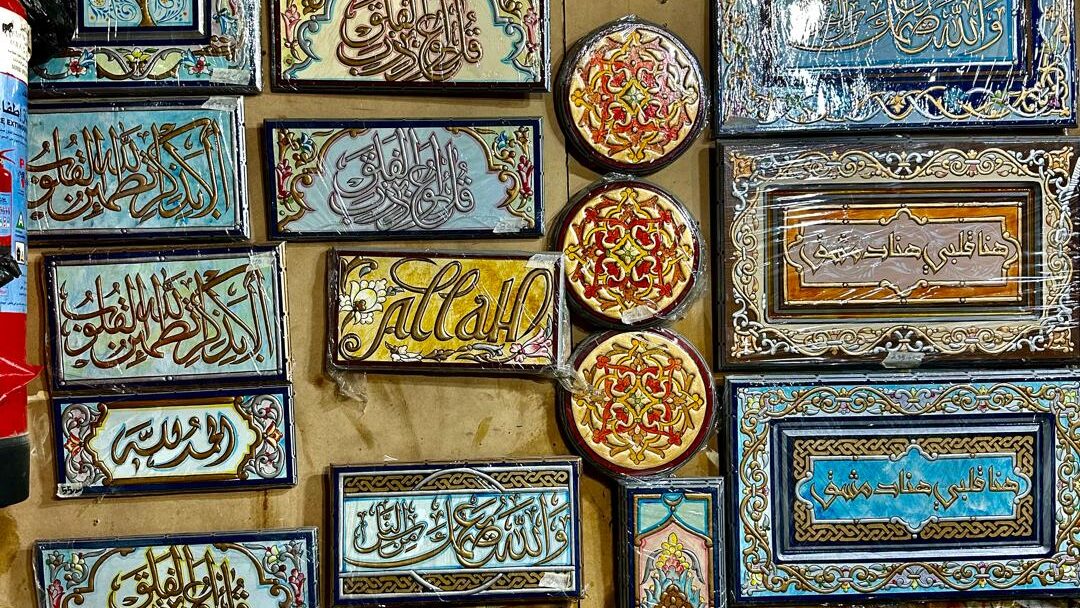
Where Can You Find This Art?
Originally, this art decorated grand ceilings and walls in mosques, palaces, and the homes of Damascus’s elite. You can still find it in places like the Umayyad Mosque and countless old houses around the city.
Today, it’s not just walls and ceilings anymore. Craftsmen have expanded the art to furniture—think beautifully decorated doors, desks, and chairs. It even appears on smaller items like jewelry boxes, makeup cases, and decorative panels.
If you’re lucky enough to visit a celebration hall or a guest room in Damascus, you might see these glowing, raised patterns welcoming guests with style and tradition. Even the Syrian Parliament’s meeting hall features this craft, showing how it represents both heritage and sophistication.
And the best part? These artworks travel the world, too. Syrians living abroad often bring small pieces with them to stay connected to their roots. Some craftsmen even create logos and commercial designs inspired by these traditional patterns.
Challenges: Keeping an Ancient Craft Alive
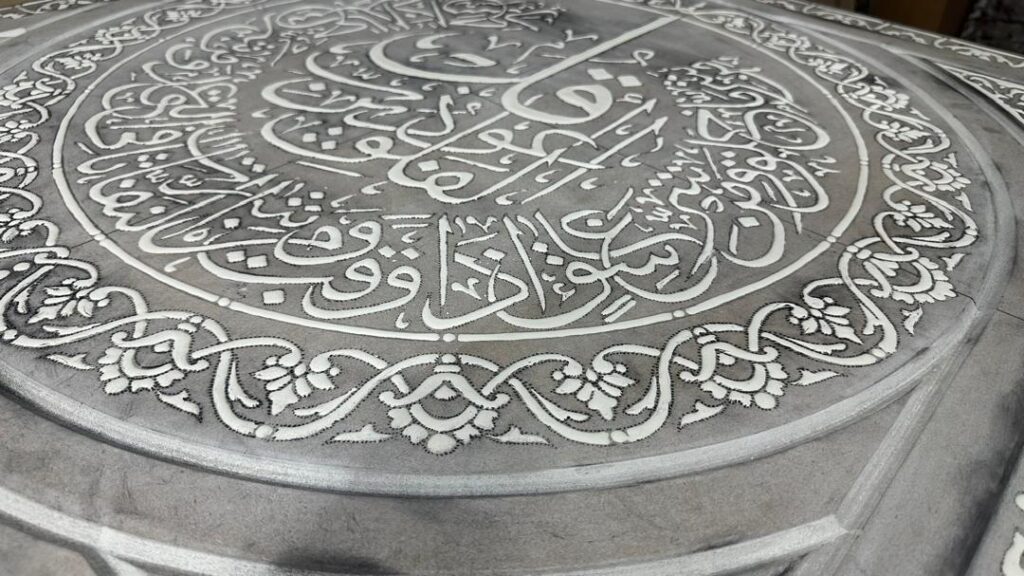
Like many traditional arts, Damascus Raised Painting faces some serious hurdles. The way people live today has changed, and fewer young people are learning the craft. It takes years to master, and the materials can be expensive.
Many workshops have closed, and there’s worry among craftsmen that this art might vanish in a hundred years if no one steps up to carry the torch. Muhammad Haj Qab shares this fear, worrying about who will continue the work after him.
There’s also a marketing gap. Many craftsmen are excellent artists but don’t know how to promote their work or reach buyers beyond Damascus. Plus, the Syrian government hasn’t provided much support or funding to help preserve this treasure.
And there’s a problem with “intruders”—people trying to copy the art without the proper skills or respect, which harms its authenticity.
How Is the Art Passed On?
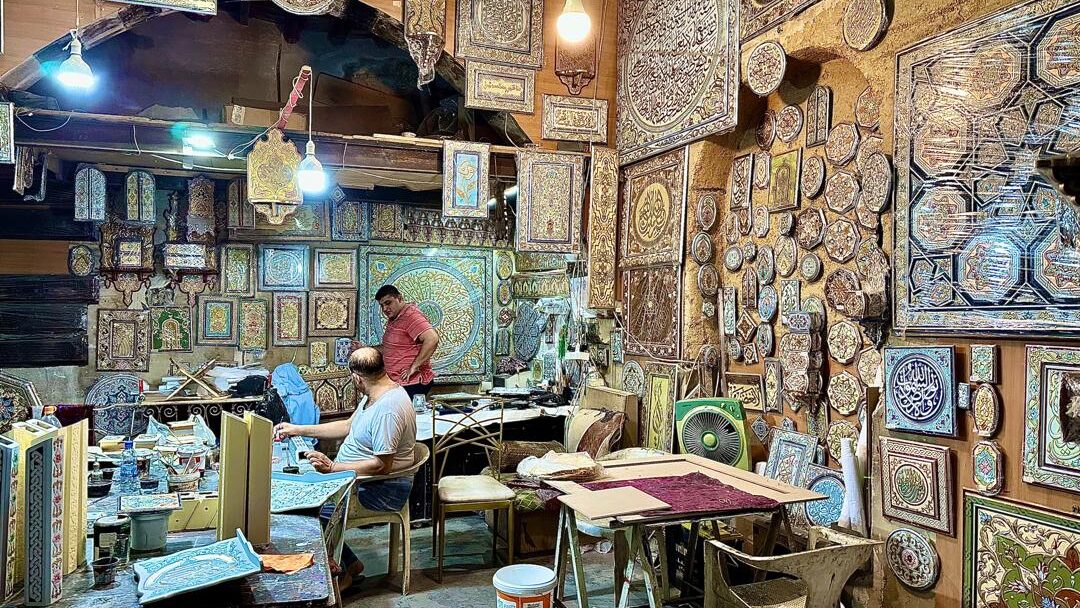
Traditionally, this craft is a family affair. Kids start learning from masters or their parents at a young age, sometimes as early as eight or twelve years old. It can take over a year just to learn the basics of drawing and transferring designs.
There are some courses offered by groups like UNESCO or the Syrian Red Crescent, and craftsmen like Muhammad Haj Qab teach students, sometimes from universities, in private classes.
Despite these efforts, the lack of formal education in Syrian universities’ Fine Arts departments is a big gap. Without official recognition, it’s harder for young people to see this craft as a viable career.
Meet Muhammad Haj Qab: The Heartbeat of Damascus Painting
If you want to understand this art’s soul, you have to know Muhammad Haj Qab. He’s not just a master craftsman but also the director of the Damascus Art Centre and one of the biggest advocates for the craft’s future.
Muhammad started learning this art as a boy and trained with masters, also studying Arabic calligraphy and photography, which added layers to his skill set. He’s traveled the world, capturing Syrian culture through his photography and sharing his passion globally.
In 2011, he won a big art competition in Switzerland with paintings inspired by Syria—though he felt the Syrian government didn’t support his work enough. He has held many exhibitions and keeps pushing the craft forward.
Muhammad believes in honoring tradition while innovating—changing colors based on where the art will be displayed or creating smaller, modern pieces. For him, the art is as vital as his heartbeat.
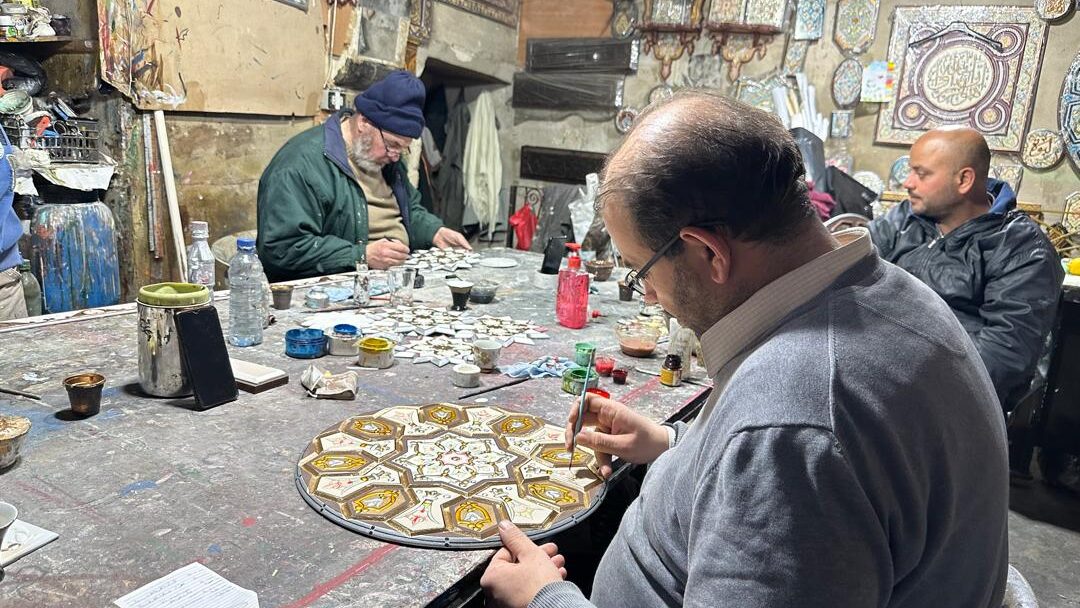
How Has This Art Changed Today?
These days, Damascus Raised Painting is not just for ancient walls. It decorates furniture, jewelry boxes, and even modern objects like makeup mirrors. Craftsmen have started experimenting with colors and adapting them to different climates—warmer tones for cold places, for example.
The art is also becoming commercial. Logos and designs for businesses sometimes use these beautiful patterns, connecting tradition with modern life.
Media, especially TV shows set in Damascus, have boosted interest and demand, especially in the Gulf countries and Europe. This exposure helps craftsmen find new customers and keep their craft alive.
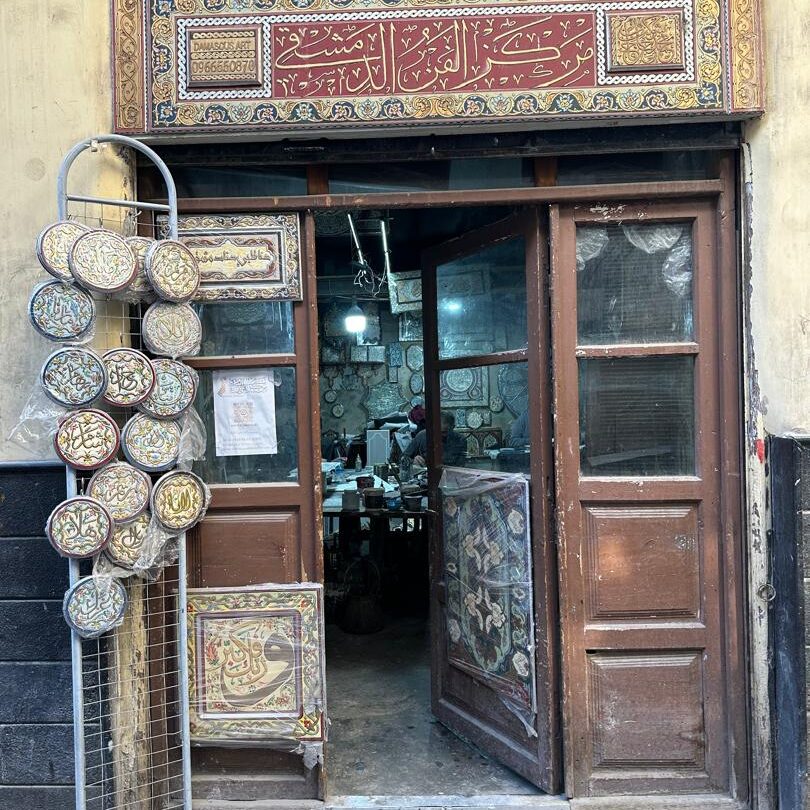
Why This Art Matters
Damascus Raised Painting is more than just decoration. It’s a vibrant expression of history, culture, and craftsmanship that connects generations. For travelers passionate about discovering unique cultural treasures, it offers a glimpse into Damascus’s soul and artistic heritage.
But it’s also fragile. Without effort to preserve and promote it, this beautiful craft might fade away. Supporting local artisans, spreading the word, and appreciating their work can help keep this tradition alive—not just for Syria but for the whole world.
So next time you visit Damascus or meet someone from there, ask about Damascus Painting. You might just uncover one of the Middle East’s most fascinating and beautiful art stories.
